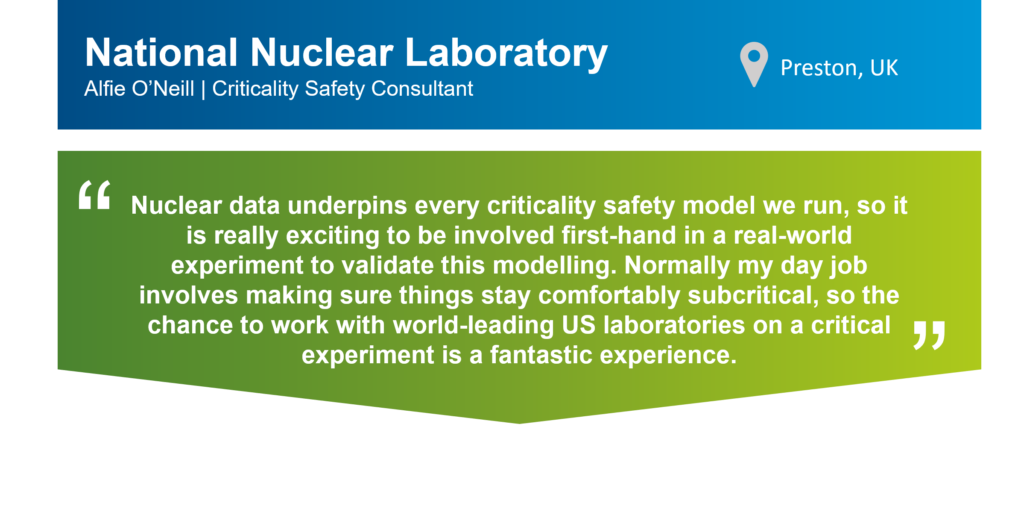Criticality cooldown: Transporting the fuel of the future
INTERNATIONAL PARTNERS | NNL | NUCLEAR DATA | PEOPLE AND SKILLSThrough modelling and prediction, AFCP’s Nuclear Data project is enhancing international understanding of future fuels. Alfie O’Neill, Criticality Safety Consultant at the National Nuclear Laboratory, details how international collaboration has created cool results for future transport.

Challenge
Sub-zero temperatures for Net Zero energy
Across the Advanced Fuel Cycle Programme’s (AFCP) integrated technical projects, there’s loads of innovative work going on to consider new fuel types and materials. Because the materials we handle have inherent risks associated with them, all this work must be supported by a comprehensive safety case. For fissionable materials which can sustain a nuclear chain reaction, this includes criticality safety assessments.
Criticality assessments, particularly for novel materials, are often based on computational modelling. We use modelling to determine how much fissile material we can have where.
But these assessments also need to consider any uncertainties in the code and underlying nuclear data, folding these into an appropriate safety margin. The greater the safety margin applied, the less material we can show is safe to handle in that aspect of the fuel cycle.
Criticality safety is all about making sure fissile materials cannot achieve a nuclear chain reaction outside a reactor. Temperature can affect whether a system is critical or not in a number of ways, from influencing the individual atomic interactions to changing the bulk density of materials. Generally, reducing temperature tends to bring a system closer to a critical chain reaction and this is primarily down to changes in the atomic interactions taking place.
Temperature effects are particularly of interest for both national and international fuel transport. International Atomic Energy Agency (IAEA) transport regulations require the demonstration of criticality safety for transport packages at ambient temperatures of -40°C to 38°C in order to cover global destinations. Previously, this was primarily considered a concern for the structural design of packages. However, the international criticality safety community has recently started to examine the neutronic affects of low temperatures in more detail, using extrapolations from existing data.
We know how well our codes work at room temperatures and above, so the uncertainties here are fairly small. However, we’ve not validated how well our codes and data perform at below room temperature. This makes it hard to quantify an appropriate safety margin, meaning the safety case must adopt a pessimistic – or conservative – and therefore more restrictive approach. To support the future deployment and transport of advanced nuclear materials, we require experimental data to validate our computational models and reduce conservatisms.
Solution
Enhancing understanding across countries
To help address this, AFCP’s Nuclear Data team at the UK National Nuclear Laboratory (NNL) is working with Lawrence Livermore National Laboratory (LLNL) in the USA on a new benchmark experiment. The experiment will involve cooling an assembly to -40°C and taking it critical. Nobody has done a criticality benchmark experiment at these temperatures before!
So far, NNL has primarily contributed thermal modelling expertise, as this was where we could add most value. Through AFCP funding for low temperature nuclear data, we are also working to fill key UK skill gaps in validation using critical experiments.
We’re doing this by addressing a range of topics under AFCP’s impact areas. These include:
- Enabling technical mentoring with subject matter experts from three different US National Laboratories: LLNL, Los Alamos National Laboratory (LANL) and Sandia National Laboratory (SDL)
- Funding attendance at and contribution to the 2020 International Criticality Safety Benchmark Evaluation Project (ICSBEP) – an OECD Nuclear Energy Agency (NEA) ongoing activity – with two NNL staff acting as members of the Technical Review Group who approve the addition of validation reports to the ICSBEP handbook
- Conducting internal training within the NNL Nuclear Safety team to share the knowledge gained
- Producing computer models in the UK criticality safety code MONK to compare against the US code MCNP, and
- Working with LLNL on sensitivity analysis of the benchmark model to support the final design of the experiment.
Impact
Industry-first innovation
This work gives the NNL Nuclear Safety team a much better understanding of the nuances of nuclear data at low temperatures and the effect this has on criticality safety. The output of the low temperature experiment will benefit the whole sector, helping to raise the UK’s profile in the international criticality validation community. Within the UK criticality community, the NNL Nuclear Safety team are also looking for opportunities to share this work at national conferences.
By working on this industry-first benchmark, we can help to quantify the uncertainties in the nuclear data and criticality safety modelling. This will help reduce the pessimisms in the safety assessments and have a direct impact on future operations, ensuring we can continue to transport nuclear materials around the world.
AFCP has also provided an important opportunity to engage criticality safety experts in the development of the data that underpins their modelling and work. This ensures that users of nuclear data understand how it is developed and how it affects their calculations.
A lack of verification of models supporting any part of the safety case for research, development or implementation in an advanced fuel cycle results in more restrictive safety case limits, which in turn can have an impact on the cost and feasibility of future operations.
This work ultimately contributes key findings to AFCP’s Nuclear Data project. We require a developed understanding of the data we rely on to model the nuclear fuel cycle. Without this understanding, the deployment of advanced fuel cycles would be hindered due to limited evidence of modelling for fuel performance at these temperatures. Nuclear data and criticality benchmarks enable us to predict fuel behaviour under different scenarios, helping us to confidently plan for a Net Zero future.
AFCP is part of the Department for Business, Energy and Industrial Strategy’s (BEIS) £505m Energy Innovation Programme.
